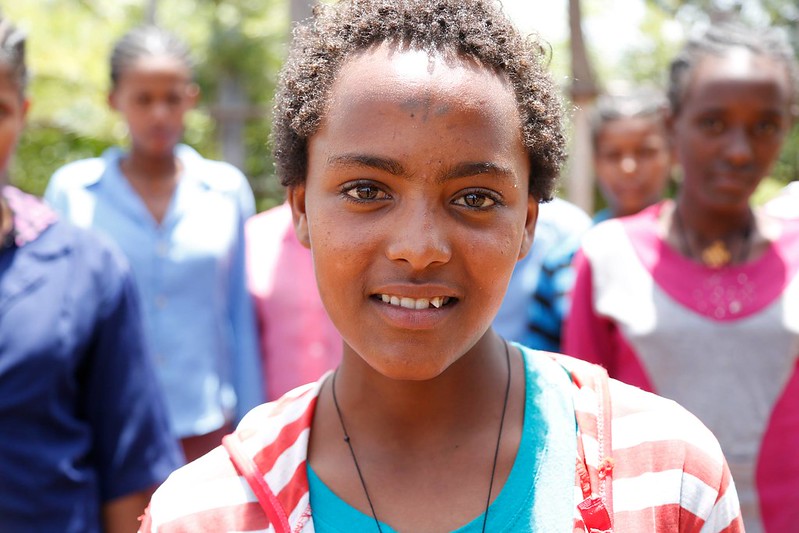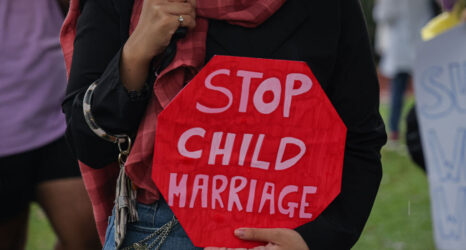How does one attain her freedoms and rights if she is forced to marry?

A resounding knock at around 9 p.m. in a snow-buried village in Bosnia. It is winter of 1994 and war is raging on the city frontline. My grandmother, aunt and mom bravely confront the unknown visitors downstairs. At the door stand two uniformed men, soldiers in heavy boots who could be on any side of the conflict seeking shelter for the night. Meanwhile, five small children are trying to fall asleep upstairs, three boys and two girls, my sister and me.
My 8-year-old self looked at these strange men puzzled, in fear, as they were holding arms and smelling stale. Only now, 30 years later advocating for gender equality and girls’ rights at the U.N., do I realize what an incredible amount of courage it would have taken the women in my family to open that door—and what incredible risks we were facing by virtue of our gender at that moment in time unbeknownst to my girl child self.
Three helpless women with five small children in wartime Bosnia. Two armed soldiers.
The soldiers were polite and grateful, and we were unharmed that night, but in 1995, we fled our ravaged country that became known for some of the worst gender-based crimes in history as the conflict was finally ending. Reading an article about rape in Bosnia in graduate school in New York City in 2010, I fainted in my library. I have spent subsequent years learning my own history retroactively—now as a woman and an advocate.
Coincidentally, at the time of my family’s flight from Bosnia in 1995, in Beijing at the Fourth World Conference on Women, thousands of activists and government representatives forged a new kind of compact. The Beijing Platform for Action imagines a world where each woman and girl can exercise her freedoms and choices and realize all her rights, such as to live free from gender-based violence, go to school, participate in all decisions about her own life, and earn equal pay for equal work.
If we traced mine or any woman’s or girls’ life trajectory, we would find unique experiences and challenges, barriers that we encounter for the mere reasons of our identity. My girlhood in conflict is just one example, one story—but every day through my work, I learn of the devastating consequences women and girls face resulting from deeply rooted harmful gender norms and practices pervasive in every society worldwide.
One of the most egregious examples of gender-based violence is child, early and forced marriage. How does one attain her freedoms and rights if she is forced to marry?
Before COVID-19, around 12 million girls married each year, 2 million before reaching their 15th birthday. My organization now estimates that the economic impacts of COVID-19 last year alone could put an additional half a million girls at risk of marriage each year by 2025.
Child marriage disrupts girls’ education, exposes them to lifelong violence and discrimination, and has proven to result in higher rates of maternal morbidity and mortality and life-threatening harmful outcomes for their children.
Compounding these direct consequences, child marriage is a fundamental barrier to girls’ participation in public life. It utterly removes their agency and voice from taking part in decisions that directly affect their lives.
To break the cycle of poverty, inequality, violence and discrimination, we must remove this barrier for all girls and facilitate their empowerment and participation.
This thought is not new. The extraordinary framework I mentioned above that is being implemented at all levels of power, albeit far too slowly, addresses twelve critical areas of concern, including the girl child. Governments and the international community committed to promote the girl child’s awareness of and participation in social, economic, and political life in Beijing.
This participation simply cannot happen in face of child marriage or similar harmful norms and practices.
Currently, at U.N. headquarters, in their negotiations of a political outcome document endorsing the Beijing Declaration and Platform for Action each year, governments in the Commission on the Status of Women are debating on the theme of women’s full and effective participation and decision-making in public life towards achieving gender equality and empowerment of all women and girls.
This space is a critical opportunity to expand the views of some governments regarding diversity of all women’s and girls’ views over the entire course of their lives, beyond just limited age categories marking adolescence or adulthood. It is an opportunity to do away with a notion that girls are not active participants and agents of change in their lives and their societies.
Public life is not limited to political participation in a formal sense and we need to ensure in implementation of the Beijing Declaration and Platform for Action that girls are granted access to training, information and media on social, cultural, economic and political issues that enable them to articulate their views. I learned through extensive direct work supporting girl advocates to speak their own truth to decisionmakers at the UN that girls have strong opinions and powerful voices, and they want to and will be heard.
Each day, we re-commit to listening.
You may also like:





